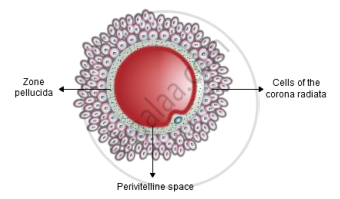Advertisements
Advertisements
प्रश्न
The following is the illustration of the sequence of ovarian events (a − i) in a human female

(i) Identify the figure that illustrates ovulation and mention the stage of oogenesis it represents.
(ii) Name the ovarian hormone and the pituitary hormone that have caused the above mentioned event.
(iii) Explain the changes that occur in the uterus simultaneously in anticipation.
(iv) Write the difference between ‘c’ and ‘h’.
(v) Draw a labeled sketch of the structure of a human ovum prior to fertilization.
उत्तर
(i) Figure 'f' illustrates ovulation. It represents the ovulatory stage of oogenesis.
(ii) Progesterone is the ovarian hormone released during ovulation. Follicle stimulating hormone (FSH) and Luteinizing hormone (LH) are the pituitary hormone released during ovulation.
(iii) In anticipation of receiving the fertilised egg, the endometrium of the uterus gets thickened and also the blood supply to the endometrium increases.
(iv) In the figure, (c) stage represents the secondary follicle and the (h) stage represents the degenerating corpus luteum.
|
Secondary follicle |
Corpus luteum |
|
It is Surrounded by layers of granulosa cells |
Layers of granulosa cells absent |
|
Presence of theca layer |
No theca layer is present |
(v) Labeled diagram of the human ovum prior to fertilization.

संबंधित प्रश्न
Ovulation is induced by a hormone called __________.
The secondary oocyte enter into the fallopian tube through the ______.
Which of the following events take place during spermatogenesis?
Extrusion of second polar body from egg nucleus occurs ______.
The immature male germ cell undergo division to produce sperms by the process of spermatogenesis.
Choose the correct one with reference to the above.
The cell which undergoes meiosis I during spermatogenesis is the ______.
The head of the epididymis at the head of the testis is called ______.
Aquatic animals in which fertilisation occurs in water are said to be
Sperms can be stored for several years in liquid nitrogen with a temperature of ______.
In spermatogenesis, at the end of the first meiotic division ______ are formed.
